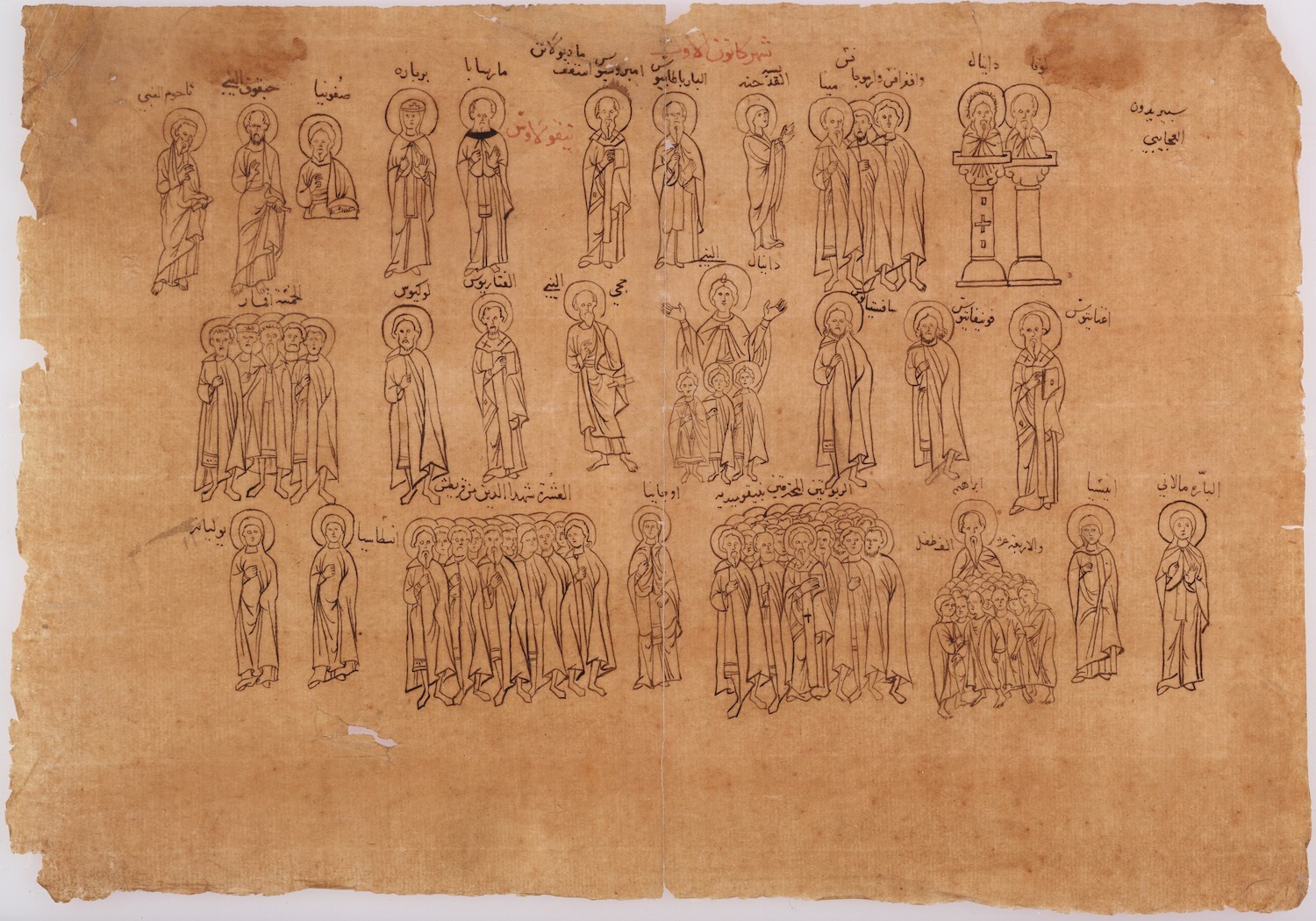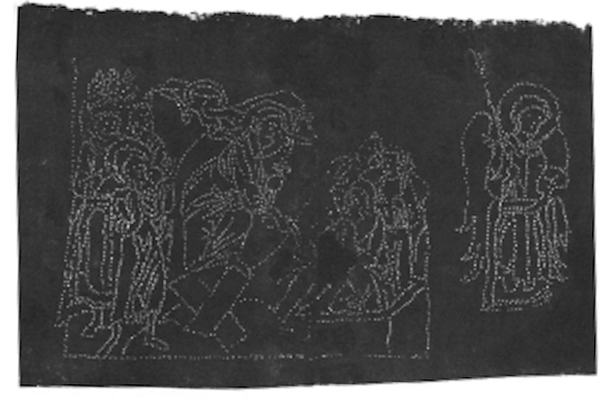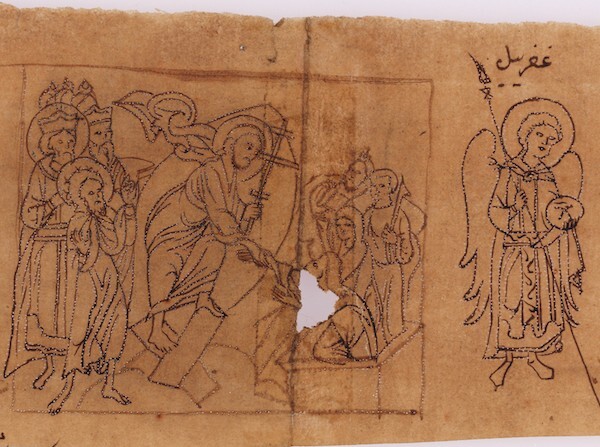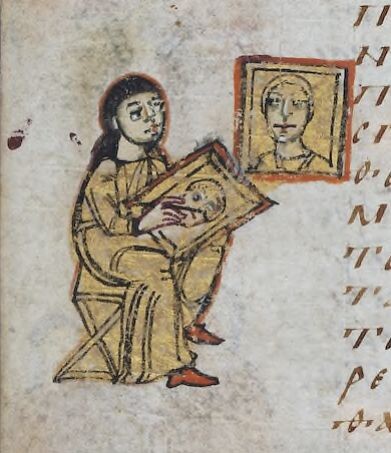These two pattern sheets were part of a gift of Edwin J. Beinecke in 1964, purchased from the New York bookseller, H. P. Kraus, along with many sheets of papyrus. Many aspects of their provenance remain unknown, but these pattern sheets prove to be a unique and invaluable source for historians of art and the history of the book. While no firm date has been established for the sheets, they are likely from the late medieval or early modern period due to the oiled paper with a possible Italian watermark.

They contain thirty outlined drawings of saints along with two narrative scenes – the Annunciation to Mary and Christ’s descent into limbo, also known as the Anastasis. As translated by Kenneth Snipes, the holy figures include
“(top row) the prophet Nahum; the prophet Habakkah; the prophet Zephaniah; Barbara, the Great Martyr; Saba the Sanctified, founder of the Great Lavra; Ambrose, Bishop of Milan; Patapius; St. Ann (the Conception of the Virgin); Menas, the Sweet-voiced, Hermogenes and Eugraphus, martyrs; Daniel and Luke, the Stylites; (middle row) Eustratius and his companion martyrs; Lucius, martyr; Eleutherius, bishop and martyr; the prophet Hagia; the prophet Daniel; Sebastian, martyr; Boniface, martyr; Ignatius, Bishop of Antioch; (bottom row) Juliana, virgin and martyr; Anastasia, martyr; Theodulus and the ten martyrs of Crete; Eugenia, virgin and martyr; 20,000 martyrs of Nicomedia; Abraham and the Holy Innocents; Anisia, virgin and martyr; and Melania, righteous matron. The small sheet contains Zacharias the Hospitable; … Gabriel the Archangel; Matrona of Salonica; and Stephen the Wonder-worker.”
The figures correspond with the Orthodox liturgical calendar’s feast days for December on the large sheet and March on the small sheet. This sequencing of saints indicates that these were likely copied from or intended for a lectionary, the Orthodox liturgical book that structures the year’s biblical readings, or for a calendar icon which features all the saints celebrated in a given month.
The frontal poses of the saints and layouts of the two narrative scenes correspond with typical Eastern Orthodox iconography. Arabic labels above the figures, which Kraus dated between the thirteenth and fifteenth centuries, provide names for all the saints, but interestingly do not provide names for the two main scenes or the figures contained therein. In Eastern Orthodox art, name and scene labels signaled to the viewer that these were representations of the holy figures and not the actual holy figures themselves. The lacking labels, especially for Christ and the Virgin Mary, would have been troubling to a Byzantine viewer. While Snipes had attributed these pattern sheets as Byzantine, their later date and Arabic inscriptions would indicate an artist likely geographically and temporally outside of the Byzantine empire. More likely these sheets came from Egypt, as the work of either an Orthodox artist or perhaps an Italian artist imitating Orthodox style, since the Italians had a strong cultural influence throughout the Mediterranean and especially in Egypt during the early modern period.
These have been identified as pattern sheets due to the unusual clustering of the figures without any corresponding main text, but more importantly because we can see evidence of their intended use by the small pinholes pricked along the lines of the scene of the Anastasis and the Archangel Gabriel on the small sheet. As Gabriel’s feet, his spear’s staff, and the upper right border of the Anastasis scene were never finished, the pricking appears to have been abandoned mid-production. The Annunciation scene and other saints do not have any evidence of pricking. Pinholes indicate that the images were intended for pouncing, a method that requires the artist to make small holes along the lines of the exemplar. The exemplar is then placed over a blank sheet and a fine charcoal powder is sprinkled on the exemplar so that the charcoal forms tiny dots that could then be connected on the new sheet, essentially connecting the dots. This method guarantees an exact reproduction of the original image in terms of size and the basic outlines of the scene, and artists could easily produce additional copies. The image below shows the pattern when light is projected through the paper. As Snipes notes, there is no residual charcoal on the paper. Combined with the fact that neither of the two pricked scenes were completed, this was likely never actually used for pouncing.


Many pattern books, some with evidence of pouncing, survive from medieval western Europe although they are often found in bound books rather than individual sheets, like Beinecke MS 553. However, no pattern books or sheets survive from the Byzantine empire. This does not mean that pouncing or pattern books were never used in Byzantium since we could assume that they were used up in the process of making images or simply did not survive, but there is no firm evidence.
The production of sacred images, or icons, in Byzantium was a theological issue. Images of religious figures or scenes were associated with dogmatic principles, the most important of which was how the incarnation of Christ made it possible to represent him in art. Icons held powerful connections with the figures portrayed therein. Paintings, then, became important tools for communication with the divine and the holy, and as such, strict beliefs governed their production. The artist was not responsible for conceiving of the images or their compositions, but rather God was the source for sacred art, with the artist as a mere translator of God’s inspiration. Artists were required to create icons that conformed with previous, divinely inspired iconographies. Regardless of the quality or medium, every icon was ultimately a copy of the holy archetype of God or the saint depicted. Church leaders carefully monitored the production of sacred images to ensure that they conformed to these divine standards. As for the technical details regarding how the artists reproduced such similar images, we have less information. A miniature from the ninth-century Sacra Parallela (Paris, Bibliothèque Nationale, MS gr. 923, f.328v, see below) shows an icon painter visually copying another icon, potentially signaling a common practice. But without any contemporary pattern sheets or artist’s notes, we are forced to make assumptions and visual inferences. A Greek Orthodox artist’s manual from the eighteenth century suggests apprentices used “sketching without measurements” and simple tracing to learn how to copy but does not give any indication that master artists continued this practice. Visual analysis of Byzantine iconography reveals that artists followed a system of proportional modules for constructing images – ratios for the division of human bodies and faces that they could repeat without the need for tracing or copying. This practice is likely responsible for the similarity of images. Without any substantial evidence, scholars of Byzantine art are largely divided on how important model books might have been in icon production.

While we may not have a definitive answer about the use of model books in Byzantium, Beinecke MS 553 adds a unique aspect to our understanding of Orthodox artistic copying. These post-Byzantine pattern sheets intended for pouncing could represent the continuation of a Byzantine tradition or could signal a later innovation in the reproduction of sacred icons. Their combination of Orthodox iconography, Arabic script, and Italian paper demonstrates the cosmopolitan mingling of the late medieval Mediterranean. Further analysis of their paper, ink, and script could potentially answer important questions about the processes of artistic production in the post-Byzantine world and its theological significance.
Notes
Kraus suggests that the sheets have the labels because “the leaves came into the possession of an Islamic dignitary who needed an explanation of the figures.” However, there is no evidence to back up this assumption.
An excellent example of the importance of labels to a Byzantine viewer is given by Sylvester Syropoulos when he recounts entering into a Latin church and not being able to venerate any of the images because he cannot recognize them without labels. For an English translation of his account, see Sylvester Syropoulos, Vera historia in Cyril Mango, The Art of the Byzantine Empire, 312-1453: Sources and Documents (Englewood Cliffs, NJ: Prentice-Hall, 1972), 254.
One only has to look to the late medieval Sicilian and Venetian churches to see their love of the Byzantine artistic style. A brief introduction to the scholarship on their imitation can be found in Otto Demus, Byzantine Art and the West (New York: New York University Press, 1970): 1-44; Ernst Kitzinger, “The Byzantine Contribution to Western Art of the Twelfth and Thirteenth Centuries,” Dumbarton Oaks Papers 20 (1966): 25-47; and Cecily J. Hilsdale, “Visual Culture,” in A Companion to Mediterranean History, edited by Peregrine Horden and Sharon Kinoshita (Malden, MA: Wiley Blackwell, 2014): 296-313.
Anke Timmermann has written about a seventeenth-century alchemical manuscript in Cambridge University Library (CUL MS Gg.1.8) that has been pricked to transmit the images therein. See her blog post: Pricking and Pouncing: Alchemical Discoveries in Special Collections. (https://specialcollections-blog.lib.cam.ac.uk/?p=7297).
For a lengthy bibliography on general scholarship surrounding medieval model books and speculations about their existence in the Byzantine world, see Torp, “The Integrating System,” 13, n51 and n52.
Bibliography
Barber, Charles. Figure and Likeness: On the Limits of Representation in Byzantine Iconoclasm (Princeton: Princeton University Press, 2002), 46, 112-114.
Cahn, Walter and James Marrow, “Medieval and Renaissance Manuscripts at Yale: A Selection,” Yale University Library Gazette 52 (1978) pp. 273-274, no. 87 [fragment 2 measures 80 x 298 mm., not 89 x 198 mm.] https://www.jstor.org/stable/40859503
Kraus, H.P. Catalogue 105: A Collection of Papyri (New York, 1964) 89-90, no. 140. http://www.worldcat.org/oclc/11168879
Kwakkel, Erik “Medieval supermodels,” in Smarthistory, August 8, 2015, accessed May 30, 2019, https://smarthistory.org/medieval-supermodels/.
Snipes, Kenneth. “A Preliminary Study of the Yale Menologium Pattern Sheets.” The Yale University Library Gazette 42, no. 3 (1968): 140–53. The black-and-white photograph is taken from Snipes’ article. https://www.jstor.org/stable/40859455
Torp, Hjalmar. “The Integrating System of Proportion in Byzantine Art: An Essay on the Method of the Painters of Holy Images,” Acta ad archaeologiam et atrium historiam pertinentia 4 (1984): 11-12, 23-105.
Vikan, Gary. “Ruminations on Edible Icons: Originals and Copies in the Art of Byzantium,” Studies in the History of Art 20 (1989): 50-51.
Additional Images: https://brbl-dl.library.yale.edu/vufind/Record/3592140
Orbis Record: http://hdl.handle.net/10079/bibid/9604196
Detailed Description: https://pre1600ms.beinecke.library.yale.edu/docs/pre1600.ms553.htm
Written by Ray Clemens (raymond.clemens@yale.edu) and Chelsea Connelly (chelsea.connelly@yale.edu).
